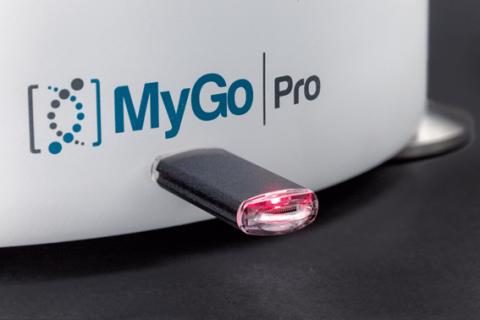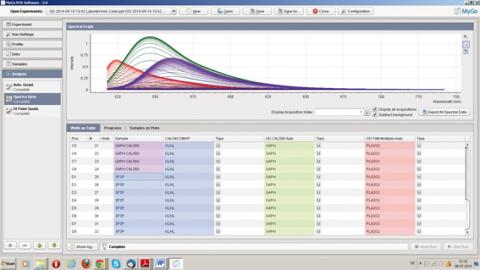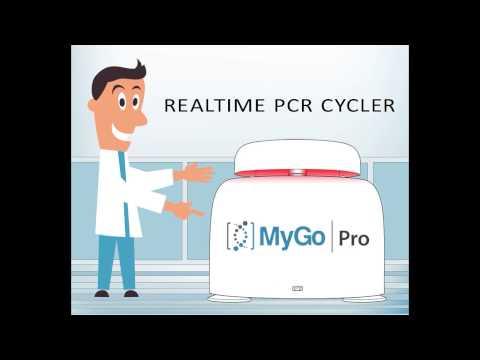Real-Time Cycler - MyGo ESR
MyGo PRO cyclers are multiplex real-time PCR devices that are suitable for a wide range of applications, including life science research, food speciation tests and the determination and quantification of viruses.
Assembled from just a few building blocks the robust real-time PCR Cycler MyGo PRO system is easy to transport and install.
Up to 32 samples can be run in 0.1 ml tubes or 8-strip format.
Fast heating and cooling is achieved by utilizing robust Peltier elements, while assay performance is supported further by a heated lid design.
Real-Time Cycler MyGo - 32 Well
Excitation is provided by high intensity LEDs filtered to provide light at 500 nm that is capable of exciting all fluorophores commonly used in qPCR.
A prism is used to generate spectra from fluorescent emissions. These spectra are imaged using a CMOS camera.
The powerful and easy to use software provides the following features:
- Automated analysis modules for:
- absolute and relative quantification
- melting curve analysis
- endpoint genotyping
- high resolution melting (HRM) - Quick start using templates for all major applications
- Analysis of full spectral data
- Generation of custom dye files for novel fluorophores
- Straightforward setup and editing of sample and target information
- Comprehensive data export functions
- Compatible with Windows, Mac & Linux Systems
- Instrument start from a USB flash drive, usingpreprogrammed settings
MyGo PRO Software is delivered and easily installed from a USB flash drive. The software has no license restrictions.
When installed in a network, the software can control several MyGo Pro Instruments connected via LAN.
| Optical Data | |
|---|---|
| No. of channels | 4 (Multiplex) |
| Fluorescence Excitation | 500 nm (blau LED) |
| Fluorescence Detection | 510 nm to 750 nm |
| Detector type | CMOS array |
| Detection sensitivity | Single copy detection |
| Dynamic range | 9-log |
| Presicion | 1.1 fold discrimination |
| Temperature Control | |
|---|---|
| Thermal system | Peltier, 99.99% silver block |
| Temperature range | 37°C to 99°C |
| Speed | 5°C/s Heating 4°C/s Cooling |
| Thermal uniformity | ± 0,1 °C |
| Thermal accuracy | ± 0,25°C |
| Factory calibrated dyes | SYBR Green I, ResoLight, FAM, VIC, HEX, ROX, Yellow 555, Red 610, TexasRed, CAL 540, CAL 560, CAL 590, CAL 610, CAL 635, JOE, Pulsar 650, Quasar 570, Quasar 670, Quasar 705, TAMRA, TET (Generic dye files, red spectral dyes will give a poorer performance). |
| Multiplex with red dyes | No |
| Supported assay formats | TaqMan®, Molecular Beacons, SimpleProbes®, Intercalators, High Resolution Melting (HRM) |
| General Technical Data | |
|---|---|
| Order No. MyGo PRO | 112.2014 |
| Number of wells | 32 well |
| Tube format | 0.1 ml tubes, 8 well strip-tubes |
| Reaction volume | 10 – 100 μl |
| Run time | <40 min (dependent on assay) |
| Status display | Lighting in the lid changes color |
| Interface | Desktop PC/laptop required Note: Protocols can be run from a preloaded USB thumb drive. |
| Software | Windows/Mac OS X or Linux operating software |
| Connectivity | LAN (RJ45), USB |
| Dimensions (W x D x H) | 25 x 27 x 23 cm |
| Power consumption | 170 W |
| Weight | 7 kg |
| Electrical Voltage, Frequency | 100 – 240 V AC +/–10%, 50 – 60 Hz +/–10% |
| Operation noise | <40 dB |
What is the minimum hold time for thermal cycling?
For holds during thermal cycling with no optical acquisitions, the minimum hold time is 3s. For holds during thermal cycling with optical acquisitions, the minimum hold time is 17s.
Can I use disposables from other vendors?
Yes. However, in order to ensure optimal performance, please ensure that any
3rd party disposables:
1) Are mechanically identical to the standard MyGo disposables, to ensure a
good fit in the mounts and correct operation of the heated lid.
2) Provide vapour tight seals when closed.
3) Are optically transparent.
4) Are biocompatible, and free of DNAse and RNAse contamination.
How do I create a template?
All experiments can be used as a template. Click “Open”, then u se the “file type” selection in the file dialog to select the “Template” option , then select the file to open as a template.
What quenchers can I use in the instrument?
For best results use non fluorescent quenchers for example BHQ. If you need to use fluorescent quenchers, e.g. TAMRA, make sure to add the fluorescent quencher to the list of targets in the sample setup to enable spectral deconvolution.
Can I clean the wells to remove potential contaminants?
Please contact technical support.
Do I need to optically calibrate the instrument before using it?
The MyGo Pro comes pre-calibrated for 22 dyes. If the dyes you want to install are pre-calibrated then you do not have to run a dye calibration.
When should I generate a dye file?
We would recommend generating dye files if you are using a dye that is not present on the list of pre-calibrated dyes. In addition, generating dye files can
help with multiplexing or other challenging applications.
Can I use dye files across multiple instruments?
Yes, dye files can be used on different instruments of the same model (i.e. MyGo Pro).
Why do some amplification curves disappear when I change from Full to Background normalisation in Auto Quant?
In Full normalisation mode the scale of low intensity amplifications is boosted.
In Background normalization mode the scale of low intensity amplifications is not boosted.
Can my dye files be used on historical runs?
Yes. To add new dye files to existing experiments, go to the “Run Settings” tab and select the “Display Dye Calibrations” checkbox, then click the “Open” button to import a dye calibration file.
How will I know if there is a new software version?
The latest version of software is available at www.mygopcr.com
Why have you not made a 96 well plate MyGo Pro?
We have prioritised data quality over the number of wells. The optical architecture which enables this in the MyGo Pro can not be used for 96 wells, because it involves fibre optics interfaced to the sides of all wells. In a 96 well block we cannot physically access the sides of all wells with fibre optics .
Do the MyGo instruments conform to the electrical safety requirements of IEC 61010 or equivalent and the electromagnetic compatibility requirements of IEC 61326 or equivalent?
Yes
Will my instrument run with empty tubes?
Yes. The MyGo Pro does not need PCR reagents to be present before performing a run. However, the MyGo Pro will not run if disposables are not loaded.
Will the MyGo Pro lid lock without any tubes in?
No. The MyGo Pro senses the presence of tubes before it locks the lid. If there are no tubes present, the lid will not lock.
I only want to run one 8 well strip of reactions in my MyGo Pro. Is this possible?
Yes, However, an empty tube strip should also be loaded so tha t rows 1 and 4 are filled.
What does integration time and acquisitions per cycle mean?
“Integration time” is the time taken by the camera in your MyGo in strument to acquire an image containing fluorescence data. “Acquisitions per cycle” is the number of images collected by your MyGo instrument per PCR cycle. For example 1s x 20 acquisitions means that the camera will collect 20 images per PCR cycle with each image taking one second to acquire.
Can I change the run settings once a run has started?
No. Once the run has been started, optical and thermal settings ca n not be changed.
Can I start a run before setting up my samples and targets information?
Yes. You can start an experiment without setting up samples and targets.
Can I change how my samples and targets are set up while my experiment is running?
Yes, the MyGo Pro will acquire data from all 120 optical channels in every well at every acquisition. This means the user can view raw data from all channels in all wells. You are not restricted to data from a channel chosen at the start of a run.
Do the instruments have built in memory?
Yes. This memory provides for a data buffer during runs to reduce the risk that data is lost due to a poor connection between your PC and the instrument.
Please ensure that you save your data on your PC once your run has finished.
Can I open the MyGo Pro lid without switching off the power to the instrument?
Yes, in the software go to Configuration > MyGo Pro > select your instrument > Open Instrument Lid.
Why don’t the MyGo instruments have power switches?
All moving parts, including power switches, represent potential points of failure for instruments. For this reason MyGo instruments do not have power switches. MyGo instruments are designed to be left connected to a power supply at all times. When not in use MyGo instruments enter a low power standby mode. If you need a power switch for your MyGo instrument, then they are available as accessories.
Do I need to use ROX as a passive reference in my MyGo instrument?
Some real-time PCR instruments require the use of ROX as a fluorescent passive reference to correct for optical artefacts. Generally, modern instruments do not require the use of passive fluorescent references. The MyGo instruments do not require the use of ROX as a passive reference.
My LAN is unreliable, how can I reduce the risk of losing data?
You can run your instrument directly from a USB drive, to which data will be saved.
Where is the threshold for determining Cq values in Auto Quant?
Modern methods of determining Cq values are not based on simple thresholds. Modern methods of Cq determination are model based. Auto Quant fits a model of a PCR amplification to the fluorescence data observed. This model fit then enables the estimation of a number of important parameters including Cq values.
Why do some of my amplification curves drop down before rising in Auto Quant?
Correct background removal in Auto Quant relies on correct qualitative calling. Please check that appropriate thresholds are set so that positive amplifications are called positive.




